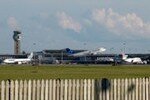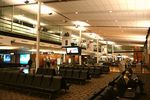Montréal, Dorval (YUL/CYUL) Canada - 1993
| Year | Minolta | Spot location | |
|---|---|---|---|
| Scan | |||
| 1993 | 3 | low quality | Inside the terminal 2 floor (closed now) |

Early days
The birth of Dorval Airport was in the 1940s. At the time, it was becoming clear that the Saint-Hubert Airport (Montreal's first official airport, in operation since 1927) could no longer meet the city's growing aviation needs. The Minister of Transport purchased the land at the Dorval Race Track, thus ensuring the best possible location for the new airport. Montréal-Dorval International Airport went into operation on September 1, 1941, as RCAF Station Lachine with three paved runways. By 1946, the airport was already hosting more than a quarter of a million passengers a year, growing to more than a million by the mid-1950s. It was primarily chosen as an airport because of good weather and few foggy days. During World War II thousands of Allied aircraft passed through Dorval on the way to England. At one time Dorval was the major transatlantic hub for commercial aviation and the busiest airport in Canada with airlines such as British Overseas Airways Corporation (B.O.A.C) landing at Dorval en route to New York City.
In November 1960, the airport was renamed Aéroport international Dorval de Montréal. On December 15 of that year, the Minister of Transport inaugurated a new $30 million terminal. It was the largest terminal in Canada and one of the biggest in the world. Montréal-Dorval International Airport was the gateway to Canada for all European air traffic, serving more than two million passengers a year.Eight years later, Montréal-Dorval International Airport underwent a major expansion program.The Government of Canada predicted that Dorval would be completely saturated by 1985, and also projected that 20 million passengers would be passing through Montreal's airports annually. They decided to construct a new airport in Sainte-Scholastique (Montréal-Mirabel International Airport). As the first phase in the transition that would eventually see Dorval closed, international flights were to be transferred to the new airport in 1975.
On November 29, 1975, Montréal-Mirabel International Airport went into service. With an operations zone of 70 km2 (27 sq mi) and a buffer zone of 290 km2 (110 sq mi), it became the largest airport in the world. Many connecting flights to Canadian centres were transferred to Montréal-Mirabel and 23 international airlines moved their overseas activities there. As a consequence, the mission of Montréal-Dorval was redefined to encompass domestic flights and flights to the United States. Dorval's traffic decreased due to the advent in the 1980s of longer-range jets that did not need to refuel in Montreal before crossing the Atlantic Ocean. Montreal's economic decline in the late 1970s and 1980s had a significant effect on the airport's traffic, as international flights shifted away from Dorval to Toronto Pearson, which serves the larger urban centre of Toronto. Lastly, international airlines, faced with the stark economic reality of operating two Canadian points of entry, opted to overfly Montreal and land in Toronto with its better domestic and United States connections.
The Trudeau government had developed Mirabel Airport to handle an expected growth in international traffic, and, eventually, to replace Dorval. That extra traffic never materialized, and due to its closer proximity to downtown Montreal, all scheduled air services have now returned to Dorval/Trudeau, while Mirabel ceased passenger operations in 2004. In May 2007, it was reported that the International Center of Advanced Racing had signed a 25 year lease with Aéroports de Montréal to use part of the airport as a race track. At the same time fixed base operator, Hélibellule, opened a facility at the site to cater for the private jets that were expected. The company also provides a passenger service from Mirabel to destinations in Canada and the United States. They operate three different types of helicopters; Bell 222, Robinson R22 and Aérospatiale Gazelle.
With all international scheduled flights going back to Montréal-Dorval in 1997, as well as charter flights in 2004, Montréal-Dorval International Airport was finally able to become a true hub, where passengers would not have to travel to different airports depending on the type of flight. The consolidation of flights to Montréal-Dorval resulted in an increase of passenger traffic, not only because of transfer of flights, but because of new connecting opportunities. In 2000, 9.4 million passengers used the airport at a time when the maximum capacity was 7 million. In 2007, the airport handled 12,817,882 passengers, a new record. The 2009 year-to-date numbers are for the first nine months of the year.
Incidents and accidents
- November 29, 1963: Trans-Canada Air Lines Flight 831 crashed shortly after departure for Toronto, killing all 118 people on board the Douglas DC-8 jet.
- June 2, 1982: a Douglas DC-9 jet exploded during a maintenance period in Montreal. No deaths.
- July 23, 1983: Air Canada Flight 143, a Boeing 767 flight originating in Dorval, made an emergency landing in Gimli, Manitoba after running out of fuel. No one was injured, and the incident became known as the Gimli Glider.
- On May 13, 2006, the Federal Aviation Administration refused permission for Biman Bangladesh Airlines flight BG011 en route from Dhaka to New York City to enter US airspace, citing safety concerns over the ailing DC-10 aircraft being used on the route. As a result the flight was diverted to Trudeau Airport where the passengers were provided with alternative airline options to complete their journey.
- August 10, 2006: Air Canada Flight 865 from London Heathrow to Montreal was among the seven planes allegedly targeted in a massive bomb plot that was being planned in Britain. The flight, scheduled for departure from London at 3:15 p.m., was canceled that day. All targeted flights, carrying between 240 and 285 people each, were to have been detonated simultaneously as the planes crossed the Atlantic Ocean. The flight flew an Airbus A330-300.
- September 23, 2007: Air Canada Flight 155 out of Trudeau Airport was forced to return because of a problem with the landing gear hydraulics. The flight was heading for Calgary. About forty minutes into the flight, the pilots discovered the hydraulics problem and returned to the airport. It made a heavy landing and a hard stop, resulting in the gear catching fire. Emergency crews extinguished the flames. All 121 passengers and five crew were evacuated from the aircraft without incident or injury.
- August 26, 2008: Air France Flight 346, a Boeing 747-400 was making a landing at the airport when it skidded off the runway and got stuck in the grass. The flight originated from Charles de Gaulle International Airport. All of the 490 passengers on board escaped with no injury


/https%3A%2F%2Fprofilepics.canalblog.com%2Fprofilepics%2F8%2F1%2F81057.jpg)
/https%3A%2F%2Fstorage.canalblog.com%2F20%2F39%2F97146%2F32300127_o.jpg)
/https%3A%2F%2Fstorage.canalblog.com%2F12%2F78%2F97146%2F30672854_o.jpg)
/https%3A%2F%2Fstorage.canalblog.com%2F26%2F90%2F97146%2F27985019_o.jpg)
/https%3A%2F%2Fstorage.canalblog.com%2F37%2F46%2F97146%2F27230276_o.jpg)
/https%3A%2F%2Fstorage.canalblog.com%2F33%2F59%2F97146%2F21981067_o.jpg)














/http%3A%2F%2Fstorage.canalblog.com%2F23%2F07%2F97146%2F14436087_o.jpg)
/http%3A%2F%2Fstorage.canalblog.com%2F48%2F68%2F97146%2F33425475_o.jpg)
/http%3A%2F%2Fstorage.canalblog.com%2F71%2F50%2F97146%2F54100451_o.jpg)
/http%3A%2F%2Fstorage.canalblog.com%2F39%2F69%2F97146%2F12012912_o.jpg)